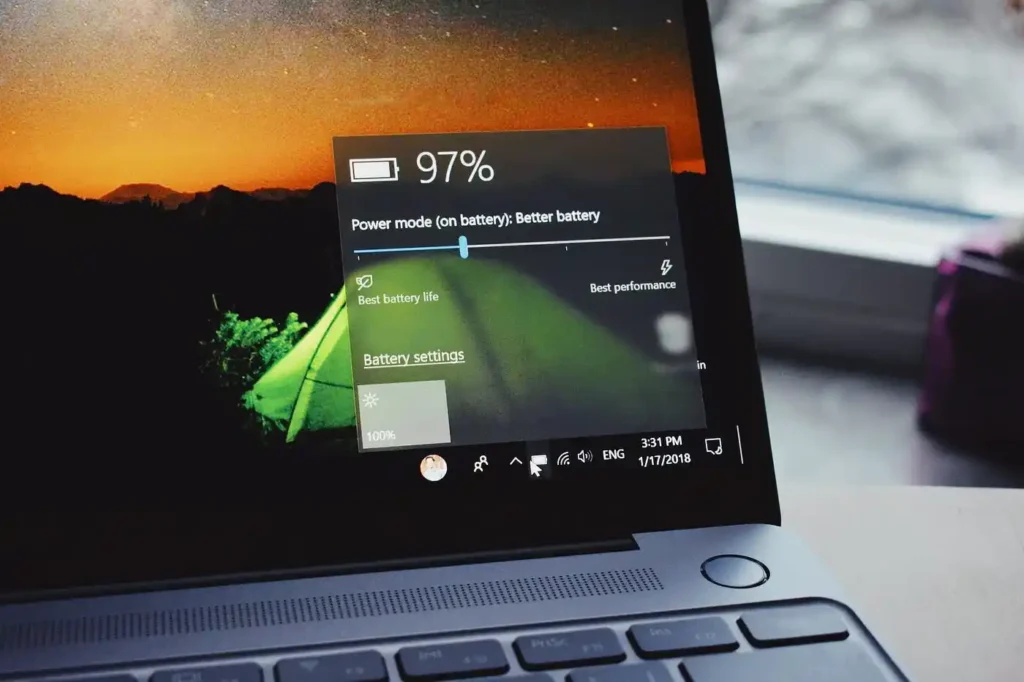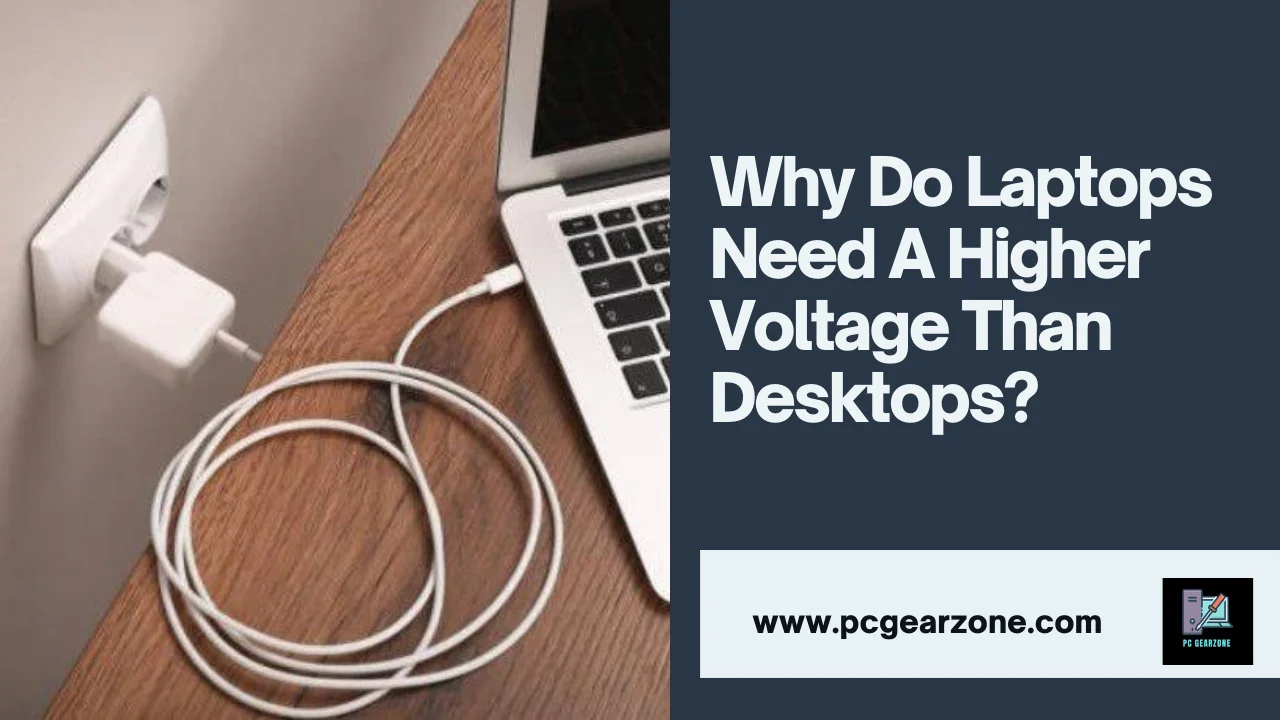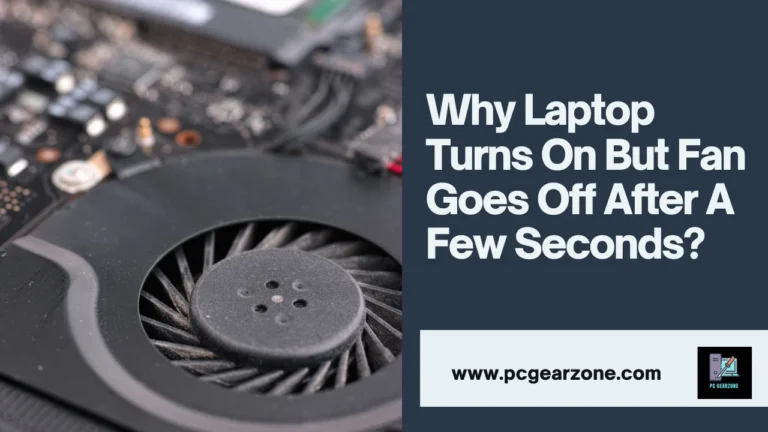Why Do Laptops Need A Higher Voltage Than Desktops?-Know All Reasons
Reviewed by: Amir Dylan
Fact Checked by: Tom David
Last Updated on: 20 August 2024
Have you ever wondered why your laptop charger is larger than the cable for your desktop PC? Knowing the required voltage of your appliances helps in ensuring safety and increasing efficiency. It may seem backward, but laptops need more volts than desktops.
In this article, I will be sharing my personal thoughts on these differences as well as some expert opinions and other relevant sources such as PDF files or books which have greatly contributed to my understanding about this matter all presented in an interesting manner that can make anyone want to read it.
Short Answer: Why Do Laptops Need A Higher Voltage Than Desktops?
Desktops prioritize portability, unlike desktop computers. This means that they are more compact and have smaller components like power supplies. The traditional power supply (PSU) for desktops can have large transformers to step down the high household AC voltage (about 110-120V in North America or 220-240V in Europe) to usable DC voltages. However, these take up too much space.
Hence laptops; which cannot accommodate this big PSU. A laptop needs higher voltage from external power brick (usually around 19 volts) because it provides sufficient “electrical pressure” to efficiently convert AC voltage down into lower DC voltages (around 3-5 volts) necessary by internal components of a laptop while still being able work with battery that has variable charge levels – between fully charged state at 10.8 volts and discharged state at 7.4 volts.

Table of Contents
What Is In The Laptop That Demand Higher Voltage From Desktop?
Mainly because of some primary components and design considerations, laptops require higher voltage.
Integrated Graphics and Processors: Laptops generally come with integrated graphic cards and processors that necessitate high voltage levels for maintaining performance at the same time minimizing size as well as heat output. These parts commonly work at about 1.0V – 1.2V to achieve optimal processing power.
Display Panels: Display panels in laptops particularly those with high resolutions and brightness settings need more volts to give clear vibrant pictures or videos. Depending on the screen technology used and size this may vary from 3.3V up to around 5V.
Battery Charging Efficiency: In order for battery charging to be efficient in laptops there is need for more volts which can be about 19 volts or even 20 volts often times. These higher voltages enables quick charging of batteries thereby allowing them run for longer hours without frequent recharges being necessary.
Power Management Systems: Laptops have got advanced power management systems that control or convert higher battery voltages (like 19V) into lower ones required by internal components (like 1.0v for processors). Such systems are designed so as to ensure optimum utilization of energy while preventing overheating.
Why Do Most Laptops And Desktops Use 19 Volts?
The incidence of 19-volt output in each laptops and laptop energy elements is a result of a combination of technical and regulatory factors.
Safety and Certification Standards:
- LPS Certification: Power substances operating at or under 20 volts can be extra without difficulty licensed as Limited Power Sources (LPS), simplifying the safety certification system and reducing costs for manufacturers.
- Manufacturing Tolerances: To ensure gadgets stay in the LPS safety limits, a 5% buffer is commonly implemented, ensuing in a fashionable output voltage of 19 volts.
Battery Charging and Internal Power Management:
- Battery Compatibility: Most computer batteries include multiple Lithium-ion cells connected in collection, with every cellular offering round 3.6 volts. A traditional 4-cell battery might have a nominal voltage of 14.4 volts.
- Efficient Charging: The 19-volt output from the strength adapter lets in for efficient charging of the battery, whilst its voltage drops for the duration of usage.
- Internal Power Regulation: Laptops rent inner switching regulators to transform the incoming voltage (either from the battery or the AC adapter) into the particular voltages required through one of a kind additives (e.G., CPU, RAM, tough pressure). These regulators make sure a stable strength deliver to the system.
Table of Component Voltage Ranges:
| Component | Typical Voltage Range (Volts) |
| CPU | 0.7 – 1.5 |
| RAM | 1.2 – 1.5 |
| Storage Drive (HDD/SSD) | 5 – 12 |
| Display | 3.3 – 12 |
| Battery Cell (Li-ion) | 3.6 – 4.2 |
What Is The Cause That Laptops Need a Higher Voltage Than Desktops?
The primary cause laptops require a higher voltage than computers is due to their inherent design constraints and electricity shipping needs.
- Portability and Size Limitations: Laptops are designed for mobility, necessitating compact components. Unlike computers with ample internal area for a conventional energy supply unit (PSU), laptops lack the room for cumbersome transformers. This forces engineers to undertake external energy bricks.
- External Power Brick Conversion: The external power brick serves because the computer’s PSU, changing the excessive-voltage alternating modern (AC) from the wall outlet to a higher voltage direct contemporary (DC). Typically, this output voltage stages from 18V to 20V, appreciably better than the DC voltages required by way of inner additives.
- Battery Management: Laptops rely on inner batteries for mobility. These batteries include a couple of cells, each handing over round 3.6 volts. To attain a enough working voltage, laptops often use a aggregate of 3 to 6 cells in collection, ensuing in a nominal battery voltage among 10.8V and 21.6V. The better voltage output from the power brick guarantees constant energy shipping even as the battery discharges.
- Efficiency and Voltage Regulation: While laptops lack the standardized form factors of desktop PSUs (ATX, microATX, and many others.), they comprise crucial voltage regulation additives to maintain solid electricity deliver to inner circuits. These additives perform optimally with a better enter voltage, contributing to standard performance.

Personal Experience:
Numerous laptop repair reviews have highlighted the significance of knowledge electricity deliver intricacies. A not unusual error is using a computing device charger, which commonly offers inadequate voltage (round 12V) in comparison to the laptop’s requirement (often 19V). This mismatch can result in severe hardware damage, along with a fried motherboard.
Another common problem includes defective energy bricks. Overheating or voltage spikes can compromise their functionality, ensuing in gradual charging, intermittent energy, or entire failure. Employing an original or compatible substitute is crucial to prevent further headaches.
Experts Opinions:
Power Supply Architecture:
- Expert Insight: Laptops typically use a strength brick that converts mains voltage (220V RMS, which peaks at approximately 311V) to a lower DC voltage, commonly round 19 volts. This eliminates the want for a bulky internal mains transformer in the laptop itself. The brick simplifies the laptop layout by coping with the conversion externally. This design preference reduces the dimensions and weight of the computer, making it extra portable.
A normal computer strength brick outputs around +19V DC, whereas desktops use internal strength supplies that convert mains voltage immediately into a couple of lower voltages, such as +three.3V, +5V, and +12V DC.
Internal vs. External Power Supply:
- Expert Insight: The key difference between laptops and desktops lies of their energy supply design. Laptops require an external power adapter to deliver a popular 19 volts DC, which is then internally regulated to lower voltages (like +5V and +three.3V) for the laptop’s components. Desktops, however, use an inner strength supply unit (PSU) that converts mains AC voltage (110V or 220V) to diverse DC outputs, such as +3.3V, +5V, and +12V.
Desktop energy elements commonly provide +3.3V, +5V, and +12V outputs from a mains input of 110V or 220V AC. Laptops, but, use an external adapter to deliver about +19V DC.
Power Conversion Mechanisms:
- Expert Insight: Both laptops and computer systems use high voltage internally for specific purposes. For instance, the pc’s external brick converts mains AC to approximately 19V DC, even as computers may have comparable excessive voltages internally, although they’re no longer exposed at once. The computing device PSU generally generates more than one outputs, even as the computer brick provides a single, higher output voltage this is internally transformed.
Desktop PSUs internally generate +3.3V, +5V, and +12V DC from mains AC voltage. The laptop power brick normally outputs +19V DC, that is then used to rate the battery and energy internal components.
Voltage Regulation:
- Expert Insight: Both structures use better input voltages to generate the specified running voltages for his or her components. In laptops, the 19V input is decreased using buck converters to supply lower voltages like 5V and 3.3V for inner additives. Desktops, the use of an internal PSU, additionally regulate higher voltages (12V) to provide the necessary +5V and +3.3V outputs.
The laptop’s energy adapter affords a higher enter voltage of about 19V, while the laptop’s PSU presents more than one outputs from an input of 110V or 220V AC, including +12V, +5V, and +3.3V DC.
Power Supply Rails and Volts:
- Expert Insight: Modern laptops use a better DC voltage (19V) for charging the battery and powering the device, at the same time as computing device PSUs normally offer +12V DC for components and further +5V and +3.3V DC for common sense circuits. The differentiation in voltage utilization is due to the layout and power distribution necessities of each machine.
Laptops usually require 19V DC for charging, whilst computer systems internally use +12V, +5V, and +3.3V DC.
Component Voltage Use:
- Expert Insight: In both laptops and desktops, better voltages are used to generate decrease voltages for the actual components. For example, laptops use 19V DC to charge the battery and strength the inner circuitry, which is then stepped all the way down to lower voltages as wished. Desktops similarly use a higher input voltage to supply various decrease voltages required for distinct components.
Laptops use approximately 19V DC to price the battery and operate, while desktops use a mixture of +12V, +5V, and +3.3V DC from their energy deliver to run numerous additives.
Does Voltage Matter For Laptops?
Yes, voltage is a crucial component for laptops. Using an wrong strength adapter may have severe effects for the device.
- Optimal Voltage Range: Laptops perform within a selected voltage variety, normally between 18V and 20V. Using a charger out of doors this range can harm the battery (reducing its capacity and lifespan) or maybe fry the motherboard.
- Overvoltage Risks: Exceeding the computer’s rated voltage by more than 5% can overload the inner components, main to overheating, component failure, or even fires.
- Undervoltage Issues: Conversely, the usage of a charger with a voltage decrease than the laptop’s requirement can result in sluggish charging, overheating of the charger, and inefficient electricity delivery.
- Battery Health: Consistent use of the proper voltage is essential for preserving top of the line battery fitness. Incorrect voltage can boost up battery degradation and reduce its normal lifespan.
- Charger Compatibility: When replacing a computer charger, it is essential to find one with the precise equal output voltage because the original. Look for specifications like “19V, 3.42A” to make sure compatibility.
What Are The Effects of High And Low Voltage In Laptops?
The ideal voltage variety for maximum laptops is usually inside a +/- 5% tolerance of the rated voltage. Exceeding those limits can cause critical effects.
High Voltage:
- Overcharging: Excessive voltage can cause the battery to overcharge, leading to swelling, overheating, or even fireplace in extreme cases.
- Component Damage: High voltage spikes can damage touchy inner additives just like the motherboard, processor, or photos card, ensuing in system instability or failure.
- Data Loss: Voltage surges can corrupt records saved at the tough power or SSD, main to potential loss of important files.
Low Voltage:
- Performance Issues: Insufficient voltage can purpose the laptop to underperform, leading to slowdowns, freezes, or unexpected shutdowns.
- Battery Damage: Chronic undervoltage can prevent the battery from charging absolutely or may even harm the battery cells through the years.
- Data Corruption: While less intense than high voltage, extended low voltage can nonetheless make a contribution to information corruption in extreme instances.
Mitigation:
To defend your pc from voltage fluctuations, consider using a surge protector or uninterruptible power supply (UPS). These devices can help clear out voltage spikes and offer backup power in case of outages. Additionally, using a super charger in particular designed on your computer is important to hold most appropriate voltage degrees.
Does a Laptop Without a Battery Consume More Electricity?
A commonplace false impression is that casting off a computer battery can result in increased electricity consumption. However, this is not entirely accurate. When a computer’s battery is absolutely depleted, the device recognizes this nation and basically bypasses the charging circuitry. As a result, the energy intake remains extraordinarily constant whether the battery is present or now not.
That stated, running a laptop with out a battery comes with exchange-offs. Laptops are optimized to paintings together with a battery, which acts as an uninterruptible energy supply (UPS), safeguarding internal additives from voltage fluctuations. Additionally, usually jogging a computer without a battery can probably shorten the lifespan of the battery itself and other additives.
Furthermore, power outages may be tricky for laptops with out batteries, as they chance surprising shutdowns and capacity facts loss.
It’s essential to take into account different elements influencing a computer’s strength intake, inclusive of battery situation (older batteries may also devour extra power), charging habits (unplugging whilst fully charged can save energy), energy-saving modes, hardware specifications (effective additives draw greater electricity), and utilization styles (aid-intensive duties increase intake).
On average, laptops eat among 30-70 watts of energy, with capacity spikes as much as 65 watts in line with hour all through stressful responsibilities. Using a computer for about eight hours day by day interprets to round 0.4 kilowatt-hours of power intake.
How Can I Decrease Laptop Voltage?
Disclaimer: While it’s technically not possible to directly lower your computer’s voltage with out editing hardware, you could significantly reduce its electricity intake, which circuitously influences the overall electrical call for. Here are some effective strategies:
- Optimize Software Usage: Close unnecessary packages and background packages. Each strolling application consumes a positive quantity of power, even when idle. For instance, closing 10 needless packages should potentially lessen strength consumption by 5-15%.
- Adjust Screen Brightness: Lowering your display brightness can result in huge energy savings. Reducing brightness via 50% can lower power intake through up to 15%.
- Utilize Power Saving Modes: Most laptops offer power saving modes. Activating these modes can lessen CPU speed, dim the display screen, and disable unnecessary functions, potentially saving up to 20% of battery existence.
- Manage Wireless Connections: Disabling Wi-Fi and Bluetooth whilst not in use can preserve energy. Constant scanning for networks can drain the battery through 5-10%.
- Consider Hardware Upgrades: While not directly affecting voltage, upgrading to greater strength-efficient additives like SSDs in place of HDDs can reduce power intake. SSDs commonly consume 20-50% less energy than traditional HDDs.
Why Does a Laptop Use Less Electricity Than Desktop Computers?
Laptops generally devour less power than desktops because of several key elements:
- Component Power Consumption: Laptops are designed for portability, incorporating lower-powered processors, graphics cards, and storage drives. This translates to noticeably decrease electricity intake in comparison to their desktop counterparts.
- Power Supply Efficiency: Laptops generally use strength components starting from 30 to ninety watts, while desktops frequently call for 300 watts or more. This giant difference in electricity supply potential directly impacts common electricity intake.
- Idle Power Consumption: When idle, laptops devour extensively less strength than computers. Modern laptops are engineered to optimize energy usage throughout durations of inactivity, extending battery existence and decreasing strength consumption.
- Workload Intensity: The sort of responsibilities achieved additionally affects energy intake. While laptops excel in ordinary duties like browsing, file modifying, and video streaming, demanding packages like gaming or video modifying may also require more power. In such instances, high-performance laptops, ready with effective components, can devour power comparable to access-stage desktops.
It’s vital to note that these are popular tendencies, and real strength consumption can vary depending on unique fashions, hardware configurations, and usage styles.
To illustrate similarly:
- Average laptops consume around 30-70 watts.
- High-performance laptops (gaming, content creation) can draw three hundred-500 watts.
- Standard desktops typically use between two hundred-500 watts.
- Performance-oriented desktops might also eat as much as four hundred watts at complete load.
- All-in-one computers provide a electricity advantage, the use of around 30% much less power than conventional computers with separate video display units.
- Tablets usually consume even much less energy than laptops, making them fantastically energy-green.
Helpful Resources:
Books and Technical Manuals:
- “The Art of Electronics” through Paul Horowitz and Winfield Hill
- This book provides comprehensive information on digital components and electricity supply layout, consisting of voltage law and power control in diverse devices.
- “Power Supply Cookbook” by using Alexander P. Severinsky
- Offers exact insights into electricity deliver design principles, such as the differences among pc and desktop energy necessities.
Technical Papers and PDFs:
- “Power Supply Design for Computers and Communications” with the aid of Mike C. McGregor
- A technical paper discussing power deliver layout, inclusive of voltage concerns for laptops and computer systems. Download PDF
- “Understanding Power Supplies and Voltage Regulation”
- An in-depth document explaining how different devices, consisting of laptops and computers, manipulate strength and voltage. Download PDF
Websites and Online Articles:
- How Laptops and Desktops Manage Power
- Techopedia article: explaining the variations in electricity control among laptops and computers.
- Laptop Power Supply vs. Desktop Power Supply
- Expert Market Research file: that discusses electricity deliver differences and their impact on laptop and desktop overall performance.
- Why Laptops Use 19V Adapters
- LaptopMag article: explaining why most laptops use 19V power adapters and how it impacts performance.
Forums and Community Discussions:
- Tom’s Hardware Forum: Power Supply Differences
- Community dialogue on why laptops and computer systems use distinctive voltage ranges and energy substances.
- Reddit: Laptop Power Requirements
- Reddit thread discussing the strength necessities and voltage desires for laptops in comparison to computer systems.
Manufacturer and Technical Support Documents:
- Dell Technical Support: Power Supply and Voltage
- Technical assist document from Dell that covers energy components and voltage requirements for his or her laptops and computers.
- HP Power Supply and Adapter Specifications
- HP’s reputable manual on power supplies and voltage specs for numerous HP pc and computing device fashions.
Conclusion:
In conclusion, laptops necessitate a higher voltage due to their compact design, reliance on batteries, and the want for green strength conversion. Unlike computers with enough area for conventional electricity materials, laptops appoint outside strength bricks to supply the necessary voltage. While this better voltage may additionally seem counterintuitive, it ensures regular energy transport, while battery degrees differ. Understanding those fundamental differences is critical for selecting the proper electricity source on your gadgets. To decrease power intake, choose energy-efficient laptops, make use of energy-saving settings, and recollect unplugging devices whilst now not in use.
Frequently Asked Questions:
Why is laptop power not directly taken from a desktop’s lower voltage?
Laptops cannot use desktop power directly due to several reasons:
Space constraints: Laptops have limited space for components, making it impractical to integrate a large desktop-style power supply.
Battery requirements: Laptops need a higher voltage to efficiently charge their batteries and maintain consistent power delivery as the battery discharges.
Efficiency: Converting higher voltage to lower voltages within the laptop is often more efficient than directly using a lower voltage from a desktop.
Why do desktops consume more power, even at idle, compared to laptops?
Desktops generally consume more power due to:
Larger components: Desktops often have more powerful processors, graphics cards, and larger cooling systems, leading to higher power consumption.
Less efficient power management: Desktops may not prioritize power saving as much as laptops, resulting in higher idle power consumption.
Does a higher voltage mean more power?
No, higher voltage doesn’t necessarily mean more power. Power (measured in watts) is the product of voltage and current. While a higher voltage can deliver more power, it depends on the current as well. Laptops often use higher voltages but lower currents compared to desktops, resulting in similar or lower overall power consumption.
Which generation of computers uses less electricity?
Newer generations of computers, both laptops and desktops, tend to be more energy-efficient. Advancements in processor technology, power management features, and component miniaturization have contributed to reduced power consumption. However, the specific power usage also depends on the computer’s configuration and workload.
Do many desktop and laptop computers provide 10W or more over USB?
Yes, many modern desktop and laptop computers offer USB ports capable of delivering 10W or more. USB-C ports, in particular, support higher power output, allowing devices like smartphones and tablets to charge quickly. Some laptops even support USB Power Delivery (PD), enabling them to charge other devices, including other laptops, through their USB-C ports.
Can I use a desktop power supply for my laptop?
No, it’s not recommended. Desktops and laptops have different voltage and current requirements. Using a desktop power supply with a laptop can damage the device.
Why do laptop chargers get hot while desktops don’t?
Laptop chargers tend to get hotter due to several factors:Power Conversion: Laptops require DC power, and chargers convert AC power to DC, generating heat in the process.
Smaller Size: Laptop chargers are physically smaller, limiting heat dissipation.
Efficiency: While modern chargers are more efficient, heat generation is still a factor.
Is it safe to use a universal laptop charger?
Using a universal laptop charger can be risky. These chargers might not provide the correct voltage and current for your specific laptop model, potentially damaging the device. It’s recommended to use the original charger.
Can I overclock my laptop’s CPU to improve performance?
Overclocking a laptop is generally not recommended. Laptops have limited cooling capabilities compared to desktops, making them more prone to overheating. Overclocking can void the warranty and potentially damage the hardware.
What factors influence the voltage requirements of different laptop models?
The voltage requirements of laptops vary based on factors such as the type of processor, battery capacity, and overall design. High-performance laptops with powerful CPUs and GPUs often require higher voltages to meet their power demands efficiently.
How does battery technology impact a laptop’s voltage needs?
Battery technology plays a crucial role in determining a laptop’s voltage requirements. Modern lithium-ion batteries used in laptops require a stable, higher voltage for efficient charging and to provide consistent power output. This helps in maintaining battery health and performance over time.
Can using a higher voltage charger damage a laptop?
Using a charger with a voltage higher than specified for your laptop can potentially damage the device. It is crucial to use the charger with the correct voltage rating to prevent overheating, component damage, or malfunction.
Why don’t laptops use the same power adapters as other portable electronics?
Laptops require more power than most other portable electronics, necessitating specialized power adapters. Unlike devices such as smartphones or tablets, laptops often need higher voltage and current to support their more demanding hardware and ensure efficient performance.
How do power requirements affect the design of laptop power adapters?
Laptop power adapters are designed to handle specific power requirements dictated by the laptop’s hardware. They include components like transformers and regulators to convert and stabilize the voltage. The design ensures that the adapter can safely provide the required power while minimizing heat generation and maintaining efficiency.
Articles You Might Be Interested:
How Do Laptops Turn Themselves Off After Shutdown?
Why Laptop Is Doing Strange Things?
Vaio Laptop Takes Too Long To Post







